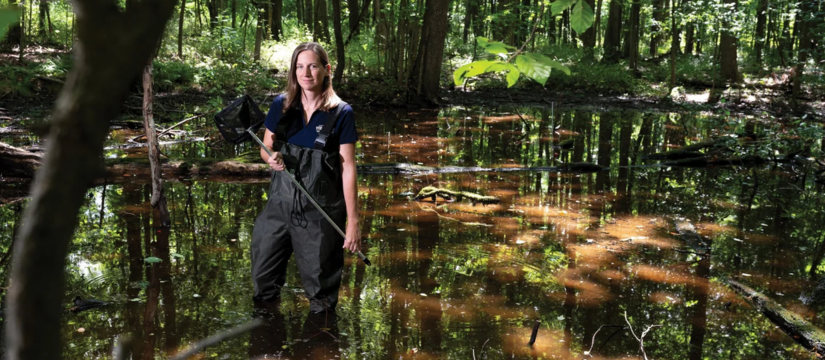Pitt’s Pymatuning Laboratory of Ecology is only one hundred miles north of the University’s bustling Oakland campus, but for some it seems like a different world. Surrounded by quiet forest on the shore of a fishing lake that straddles the Pennsylvania-Ohio state line, Pitt students and researchers have enjoyed field and laboratory experiences here for generations. Known informally as PLE, the facility has space for large-scale research and ecosystems studies where students and researchers can get their hands on plants and animals in their natural environments.
“We often have visitors from within the University who don't realize what we are and what we do, because we are a bit farther away,” says Cori Richards-Zawacki, director of PLE. “They are always surprised by the breadth of what we do and the lab resources we have available. So, we are really trying to grow that footprint and find ways to connect with the University at large. A lot of folks could benefit from the resources we have.” In addition to students in geology and environmental science, PLE has also recently welcomed students and researchers studying public health and pathology, as well as writers’ retreats.
 Richards-Zawacki, who is also a Pitt professor of Biological Sciences in the Kenneth P. Dietrich School of Arts and Sciences, hopes to expand PLE’s user base and awareness of their conference and meeting facilities, with space and resources for activities beyond research.
Richards-Zawacki, who is also a Pitt professor of Biological Sciences in the Kenneth P. Dietrich School of Arts and Sciences, hopes to expand PLE’s user base and awareness of their conference and meeting facilities, with space and resources for activities beyond research.
“We host conferences and retreats for different departments,” Richards-Zawacki says. “We are inexpensive compared to a hotel conference facility. For some University people, the first exposure to us was last year during the eclipse because we were in the path of totality. Lots of people came up to watch.”
PLE has been an important home for research in a National Science Foundation (NSF)-funded program studying biological resilience, now in its final year of funding. Richards-Zawacki is the program’s principal investigator and co-director, collaborating with researchers at nine other universities.
The project studied the effects stress has on ecosystems, with a unique focus on how and why living systems recover from stress—a phenomenon known as resilience. The team studied amphibian populations that had been decimated by a fungal disease called chytridiomycosis, focusing on frogs from sites in California, Pennsylvania, Panama and Brazil. Interestingly, populations have begun to recover despite the persistence of the pathogen. In a nod to the role of frogs, the consortium was named Resilience Institute Bridging Biological Training and Research—with the acronym RIBBiTR.
RIBBiTR-related work at PLE has created an innovation that makes low-cost, genomics-based techniques available to researchers in the field. Although advanced DNA editing techniques have revolutionized biological research, field researchers and smaller labs wanting to use this technology face some daunting challenges: high costs, as well as the need for complex training and dedicated laboratories that might be located far from where the fieldwork is being done. Many field researchers cannot benefit from the techniques, particularly researchers working in the remote sites of the RIBBiTR project.
To overcome these challenges, Richards-Zawacki was part of a team headed by then-Pitt postdoc Brandon Hoenig that produced one of the first viable alternatives to these complicated lab-based techniques. Their method was based on CRISPR, which is known to be a powerful tool for gene editing but also detects nucleic acid markers left by diseases.
The technique developed at Pymatuning (FINDeM, for Field deployable Isothermal Nucleotide-based Detection Method), is a field-friendly approach for DNA-based organism detection that requires only standard laboratory plastics, inexpensive reagents and supplies, as well as a little heat.
The detection kit can fit in a backpack. It consists of just test tubes, a heat pack (like a hand warmer), a black box with a UV light, cellulose discs, a salad spinner and micropipettes. It can detect molecular-level traces of disease without freezing the samples and transporting them to a laboratory. This is especially important for RIBBiTR researchers working in Brazil and Panama, where fitted out labs do not exist and samples must be transported back to the United States, which represents its own logistical and permitting difficulties.
"Our RIBBiTR findings have implications beyond frogs," Richards-Zawacki says. "People can use our method with other animal diseases—including zoonotic diseases—across the globe, which can have real impact on the health of our planet and its inhabitants."
If you are interested in learning more about RIBBiTR or how your team can benefit from PLE, the team encourages the University community to visit. PLE is available for scientific conferences, academic retreats and other education-related activities and offers lakeside accommodations, food and customer service. Please note that conference dates are not available from mid-May to early August when field courses are in session.
Questions?
For information about events, research and educational activities, email PLE's assistant director at chris.davis@pitt.edu or call 814-720-6614.